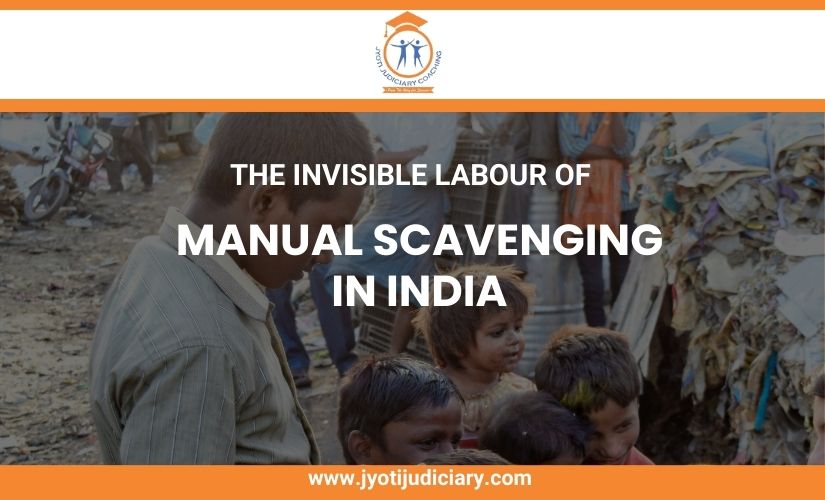
A gloomy reality that numerous individuals are often blind to exists amid the maze-like streets and cities of India. It’s the truth of manual scavenging, a centuries-old custom that hinders the development of the country. Manual scavenging is illegal and deemed cruel, yet millions of people continue to suffer from it, and it perpetuates an endless process of dehumanizing and exploitation. The gritty underside of India’s social structure can be seen in the unseen labour of manual scavengers, buried beneath the veneer of modernization and development.
Manual Scavenging in India
- “Manual scavenging” is the inhumane practice of manually removing human excrement from “dry latrines,” or bathrooms without the convenience of a flush mechanism.
- Following British rule, there was an urbanization phase during which manual scavenging became a regular practice. Even while the ultimate law of our land, the Indian Constitution, protects us from such behavior, it is nevertheless the worst kind of human rights violation.
Manual scavenging laws India
Constitutional Safeguards: The Indian Constitution provides manual scavengers with several rights and protections, including:
- Article 14 of COI: Equality before the law and equal treatment under the law.
- Article 17 of COI: The practice of untouchability is outlawed in all forms and abolished.
- Article 21 of COI: Defense of individual freedoms and life.
- Article 23 of COI: Prohibition of forced labour and human trafficking.
Legal Provisions:
- Untouchability was made illegal by the Untouchability (Offences) Act of 1955. Untouchability became a cognizable and non-compoundable practice.
- Employing someone from a scheduled caste or tribe to perform manual scavenging is illegal according to the SC/ST (Prevention of Atrocities) Act, 1989.
- The 1993 Manual Scavengers and Construction of Dry Latrines (Prohibition) Act imposes penalties on people who hire manual scavengers and those who build dry latrines or toilets.
- The primary law intended to outlaw and abolish manual scavenging in India is the Prohibition of Employment as Manual Scavengers and their Rehabilitation Act, 2013. It also prohibits hiring or employing someone to perform the task of a manual scavenger, as well as constructing or maintaining unclean latrines.
Human rights and manual scavenging
- Scavenging by hand is an abhorrent breach of fundamental human rights and dignity.
- Manual scavengers are subject to a variety of health hazards, including toxic gasses and microorganisms that can cause leptospirosis, hepatitis, and Helicobacter infections.
- Sadly, a number of manual scavengers are killed every year in septic tank and sewage accidents that may have been substantially avoided with the right tools and safety precautions.
Effects of manual scavenging
- Health Hazards: Because manual scavengers are directly exposed to dangerous materials and human waste, they are at serious risk for health problems.
- Human Rights and Dignity Violations: Manual scavenging clearly violates the participants’ human rights and dignity.
- Trauma to the Mind and Emotions: Manual scavenging can cause serious trauma to the minds and emotions of those who participate.
Alternative employment for manual scavengers
- Robotic mechanical sewer cleaning offers a secure and effective substitute for human scavenging.
- Building environmentally friendly restrooms: Under SBM, aid and information sharing should be used to promote models such as the Namma Toilets of the Tamil Nadu Municipal Corporation.
Rehabilitation for manual scavengers
The Ministry of Social Justice and Empowerment launched the Self Employment Scheme for Rehabilitation of Manual Scavengers (SRMS) in January 2017 to help the identified scavengers and their dependents find new careers.
November 2013 saw an amendment to the SRMS in compliance with the “Prohibition of Employment as Manual Scavengers and their Rehabilitation Act, 2013 (MS Act, 2013)”.
- For those who are interested in launching their own businesses, loans and subsidies are offered. The goal is to completely eradicate mortality from manual scavenging.
- The NAMASTE program, which aims to mechanize sewer work entirely, has combined with the program for the rehabilitation of manual scavengers.
- The FY 2023-24 Union Budget allots ₹100 crore to the NAMASTE program but does not specifically fund the rehabilitation program.
- All septic tank and sewer workers must be identified and profiled, provided with safety gear and occupational training, and enrolled in the Ayushman Bharat health insurance program in order to comply with the NAMASTE plan.
It is crucial to realize that manual scavenging affects the underprivileged segments of society in India and is a problem in both urban and rural areas. Consequently, a comprehensive strategy that includes economic empowerment, technology advancements, legal enforcement, and, above all, cultural transformation to eliminate caste-based prejudice is needed to end manual scavenging. Eliminating manual scavenging becomes a crucial step in India’s journey toward modernity, representing the values of social justice and equality.
Manual Scavenging in India FAQs
1. What is the current status of manual scavenging?
Manual scavenging is the process of physically removing human excreta and other garbage from open drains, sewers, and dry latrines and treating them. In India, manual scavenging has long been an issue, despite being illegal since 1993.
2. Does transgender have right to vote in India?
All states were ordered by the Supreme Court in its historic 2014 ruling to outlaw manual scavenging and take action to rehabilitate these individuals; 58,098 manual scavengers have been identified as of late, but the true number is probably far higher.
3. Which state first banned manual scavenging?
According to entry 6 of the Constitution, sanitation is a state responsibility. As a result, Delhi became the first state in India to outlaw manual scavenging when they made the announcement in February 2013.
4. What are the steps taken by the government to stop manual scavenging?
The Union and State Governments have received many directives from the Supreme Court to ensure that the reprehensible practice of manual scavenging is completely eradicated by strictly enforcing the Prohibition of Employment as Manual Scavengers and their Rehabilitation Act, 2013.
5. Who are mainly involved in manual scavenging?
The majority of Dalits employed in sanitation jobs in the caste-based society are manual scavengers, drain cleaners, garbage collectors, and road sweepers.
6. Is manual scavenging a crime?
It is against the law to hire a manual scavenger or someone to clean a sewer in a dangerous manner without wearing safety gear. Building an unsanitary toilet that needs a manual scavenger to remove the human excreta that hasn’t broken down is against the law.
7. What are the problems with manual scavengers?
The gases carbon dioxide, ammonia, and methane are among those to which the scavengers are exposed. Prolonged exposure to these gasses can cause fatalities or major health problems.
8. Which robot is used for manual scavenging?
Bandicoot is a “remarkable” invention that aims to end manual scavenging in India. Its inventors, who came up with the concept while still in school, should be “encouraged and appreciated.”
9. Why is manual scavenging called the worst violation of human rights?
Not only does manual scavenging infringe the right to life and liberty, but it also violates the basic right to health and the right to dignity.
10. What are the efforts to end manual scavenging?
The Employment of Manual Scavengers and Construction of Dry Latrines (Prohibition) Act of 1993 outlawed manual scavenging. However, a more stringent law, the Prohibition of Employment as Manual Scavengers and Their Rehabilitation Act, changed this again by allowing manual cleaning with safety precautions only in locations where machines cannot be used.
11. What is the fate of manual scavenger in India?
The Court ordered the complete elimination of the manual sewer cleaning process and the guarantee that no one must manually enter sewers for any reason. The directives in the matter of Dr. Balram Singh v. Union of India and others were issued by a bench made up of Justices S Ravindra Bhat and Aravind Kumar.
With the goal of giving students the best coaching available for law entrance exams including the CLAT, AILET, and various other numerous state judiciary exams, Jyoti Judiciary Coaching, India’s Finest educational Platform, was established. Come enrol now with Jyoti Judiciary!
For any latest news, legal topics, judiciary exams notifications, patterns, etc watch Jyoti Judiciary’s YouTube channel for legal videos for any updates at https://youtube.com/@jyotijudiciarycoaching4852?si=2cwubh9d2A9urwJf










